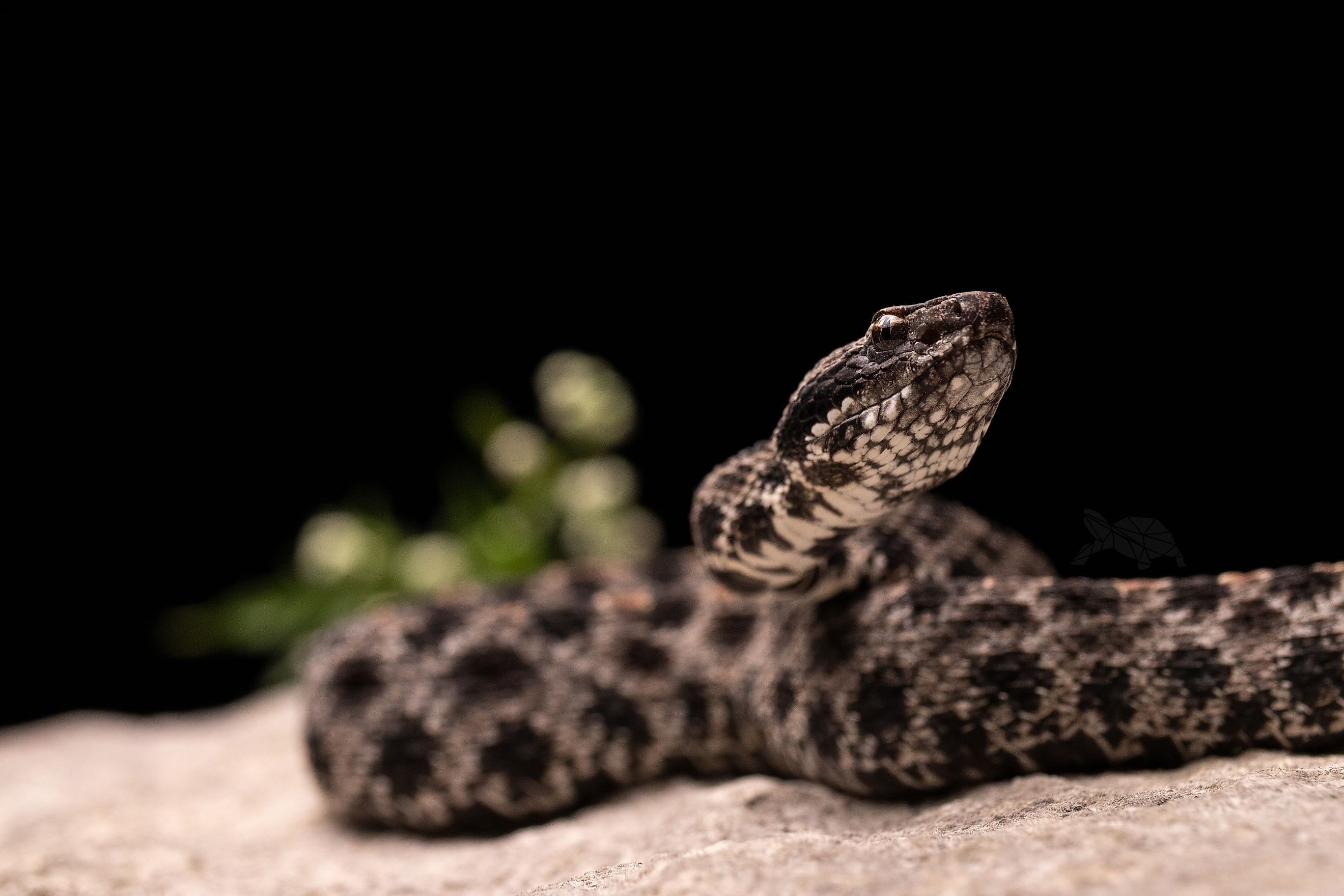
Which State Has More Venomous Snakes: Florida or Louisiana?
Both Florida and Louisiana have significant populations of snakes. This is due to the ideal living conditions for these cold-blooded reptiles, including generally warm weather, an abundance of food sources, and environments in which they can hunt and nest. If the amount of venomous snakes that live in a certain place is a deciding factor for you to either visit or not, then you should read on to figure out which of these two southern states appeals to you the most. This article will look deeper into which species of venomous snakes live in Florida and Louisiana and which has the most by species and sheer volume.
What Kinds of Venomous Snakes Live in Florida?
Florida is well known for its reptile populations, with alligators, turtles, lizards, and, of course, snakes, being abundant here, mainly in its vast swamps and grasslands. The Everglades, for example, is an incredibly popular national park and wetland where many of the snakes mentioned on this list can be found. The lesser-known grasslands in the central regions of Florida, away from the coasts, are other hotbeds for snake populations.
Six main venomous species live within the borders of the state of Florida. If you are a resident of the state, how many of these have you seen slithering around?
Eastern Coral Snake (Micrurus fulvius)

The eastern coral snake (Micrurus fulvius) is a venomous snake found throughout Florida. It is known for its distinctive bright red, yellow, and black banding, which serves as a warning to potential predators. At full maturity, it grows to around 1 meter, or about 3.5 feet long. The eastern coral snake's neurotoxic venom can cause severe respiratory failure if not treated promptly. Despite its potent venom, it is reclusive and rarely bites humans unless provoked. Moreover, they spend most of their time underground, so human interactions are pretty rare.
Eastern Copperhead (Agkistrodon contortrix)
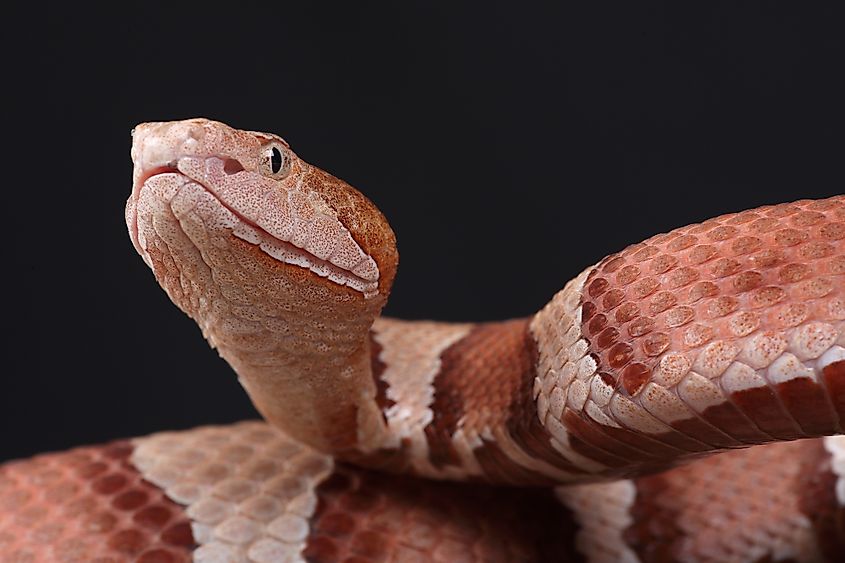
The eastern copperhead (Agkistrodon contortrix) is native to much of the eastern United States. It is easily identified by its coppery head and distinctive hourglass-shaped bands on its body. Copperheads are also one of the largest species in the region, growing to about 37 inches (95 cm) in total length, with larger specimens clocking in at up to 53 inches (135 cm). These snakes prefer forests, rocky areas, and fields, which are abundant in Florida. Their venom is hemotoxic, but a lethal dose is around 100mg, making it rarely fatal to humans. They are generally non-aggressive and rely on their camouflage to avoid detection, striking when threatened or accidentally stepped on.
Florida Cottonmouth (Agkistrodon conanti)
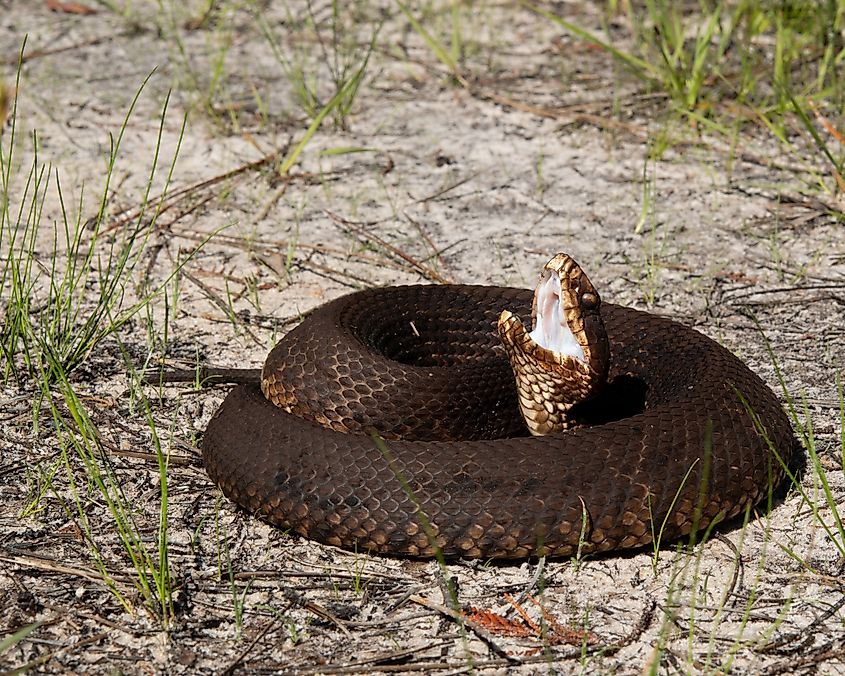
As the name suggests, the Florida cottonmouth (Agkistrodon conanti) is one of the more famous species in Florida. Also known as the water moccasin, it is a venomous pit viper found in much of the southeastern United States. The snake is known to live in all kinds of wetlands, from offshore islands to brackish water. Florida cottonmouths are recognizable by their thick, dark body and white-lined mouths. At full maturity, these snakes can grow to a modest 48 inches (122 cm). Their venom is potent, causing severe tissue damage. Even with its aggressive reputation, the Cottonmouth typically avoids human interaction and only bites when threatened.
Pygmy Rattlesnake (Sistrurus miliarius)
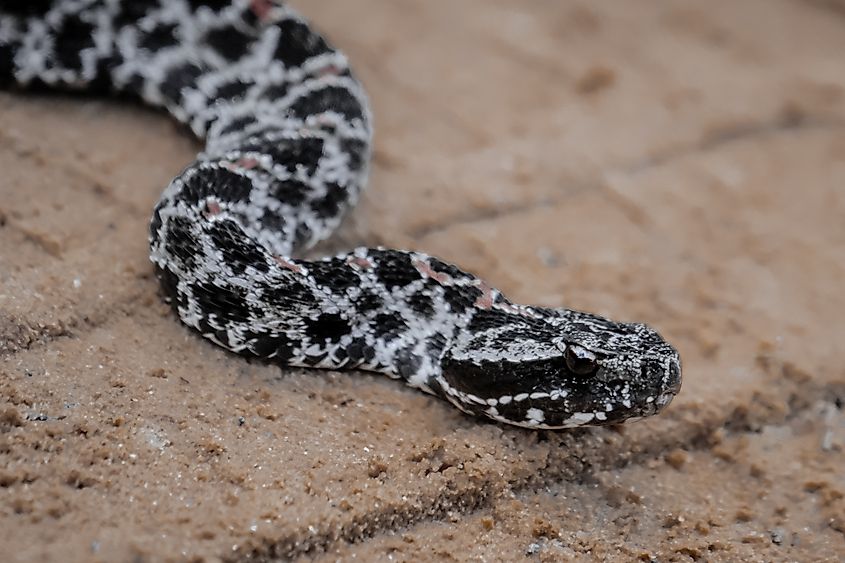
The pygmy rattlesnake (Sistrurus miliarius), sometimes called "ground rattlers," is quite small and has a stout body with gray or tan coloration and dark blotches. It generally only ranges from 16 inches to 24 inches (40 to 60 cm) in length, making it one of the smallest venomous snake species in the country. Known for its tiny rattle, the Pygmy Rattlesnake prefers forests and grassy areas where it can easily hide from prey. To this end, it is an endemic species to the Southeastern United States and can be found in various parts of Florida. Though the pygmy rattlesnake’s venom is potent, bites are rarely fatal to humans, and prompt medical care can ensure a quick recovery.
Timber Rattlesnake (Crotalus horridus)
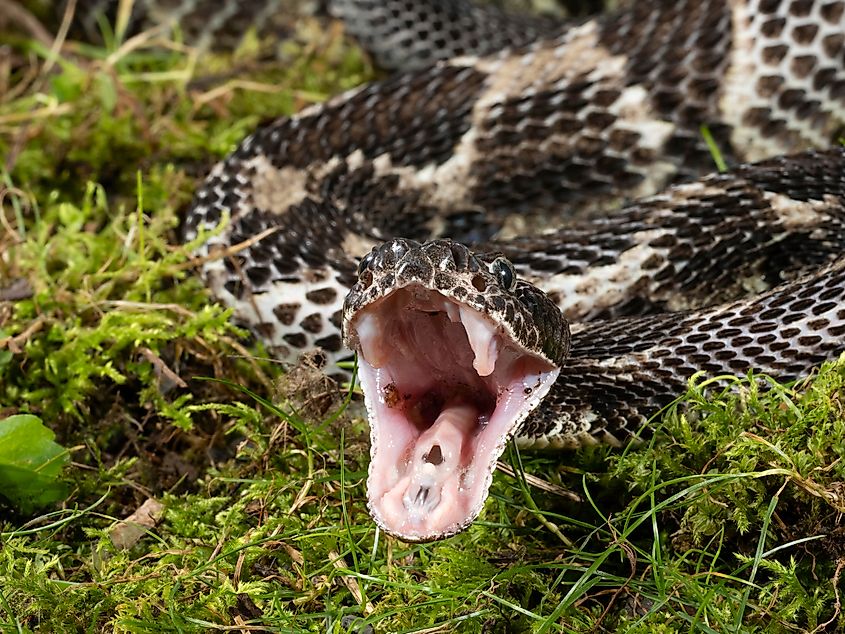
The timber rattlesnake (Crotalus horridus) is a fairly large species of venomous snake in Florida, averaging up to 60 inches (152 cm) long when fully grown. Recognized for its distinctive pattern of dark, V-shaped crossbands on a lighter beige background, it inhabits forests and rocky hillsides. Its venom can cause severe tissue damage, but fatalities are rare due to its shy nature and tendency to avoid humans. That said, the venom is highly effective on smaller animals, and the timber rattlesnake preys on everything from small birds to frogs and even other snakes. They are also among the more endangered snakes in Florida, and conservation efforts are crucial.
Eastern Diamond-Backed Rattlesnake (Crotalus adamanteus)
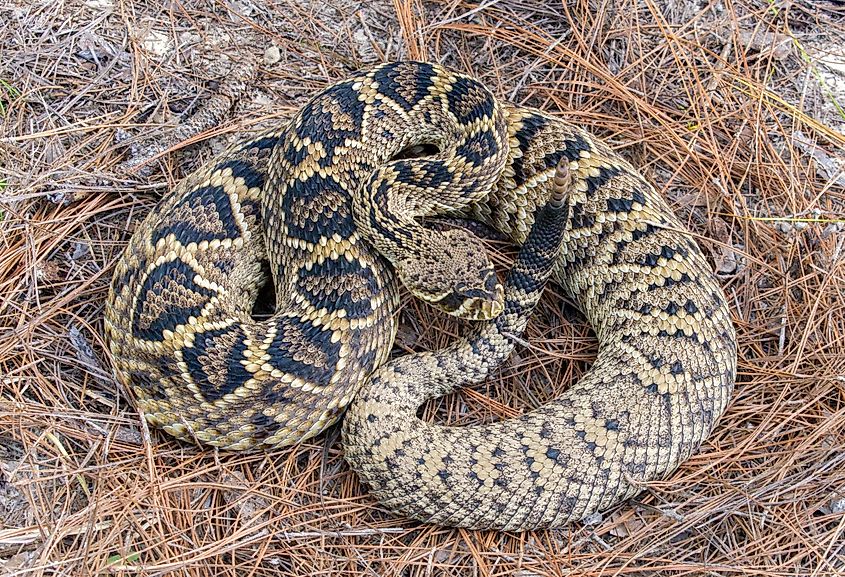
The eastern diamond-backed rattlesnake (Crotalus adamanteus) is the largest venomous snake in North America. This snake species can come in a relatively wide range of sizes, with adult specimens often ranging from 3.5 feet to 5.5 feet (1.1 m to 1.7 m). However, some snakes can cross this limit, and the largest recorded eastern diamondback measured a whopping 7.8 feet (2.4 m) and 34 pounds (15.4 kg). It has a diamond pattern along its back and, as you probably could have guessed, a distinct rattle at the end of its tail. Preferring dry habitats like pine forests and coastal scrublands, it hunts small mammals with its potent venom. With a fearsome reputation, you may surprised to hear that typically avoids human encounters, a commonality among many snakes, big or small.
What Kinds of Venomous Snakes Live in Louisiana?
Louisiana is said to have seven main venomous snake species living within its borders in the deep south of the United States. With a fairly similar environment to Florida, it is no surprise that the two states share many of the same venomous species, including the eastern diamondback rattlesnake, timber rattlesnake, pygmy rattlesnake, eastern copperhead, and the harlequin coral snake. Like Florida, Louisiana contains a mix of swamplands near the coast and drier grasslands near the upper interior of the state, both providing excellent conditions for a variety of snakes to live in. Here are the other distinct species:
Texas Coral Snake (Micrurus tener)
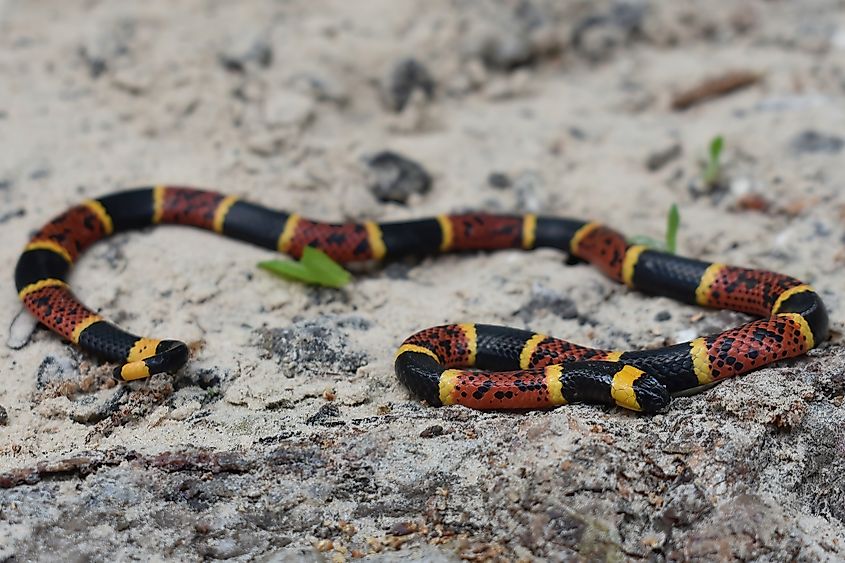
The Texas coral snake (Micrurus tener) is found primarily in Texas and parts of neighboring states like northern Louisiana. Known for its distinct color pattern of red, yellow, and black rings, it uses its neurotoxic venom to immobilize prey. Texas coral snakes can reach lengths of 48 inches (122 cm), with most specimens ranging between 20 and 30 inches (51 and 76 cm). They inhabit various habitats, including woodlands, grasslands, and scrub areas, and are reclusive and reluctant to bite unless provoked. While quite shy, the Texas coral snake is almost fully cannibalistic, and its diet primarily consists of earth snakes and other smaller snake species.
Northern Cottonmouth (Agkistrodon piscivorus)
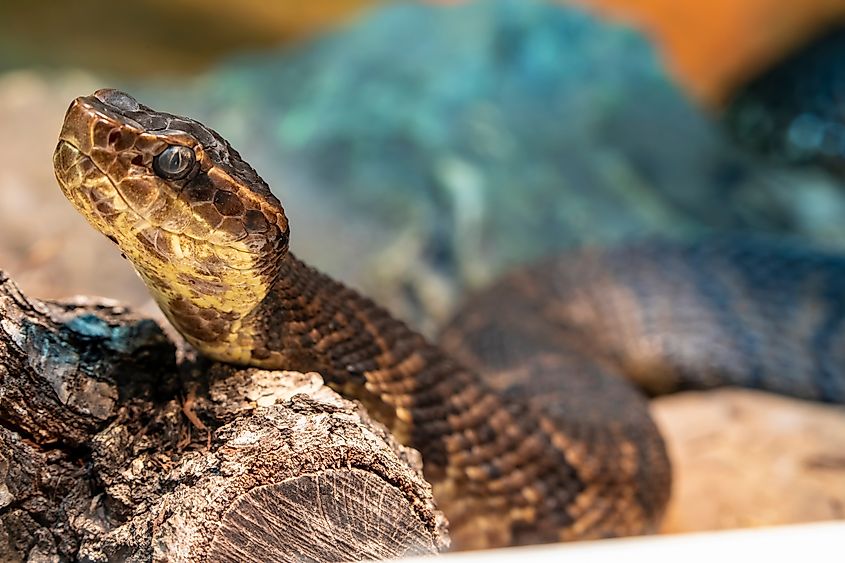
The northern cottonmouth (Agkistrodon piscivorus) is known for its thickly built body and distinctive facial markings. Specifically, this snake boasts a dark coloration, sometimes completely black, with brownish bands along its back. The northern cottonmouth is usually measured at 30-48 inches (76-122 cm) when fully grown, with the record hitting a lengthy 74 inches (188 cm). Like many snakes called "water moccasins," these snakes are often found near water and feed primarily on fish and amphibians. Its venom, while potent and hemotoxic, is rarely fatal to humans. Despite its aggressive reputation, it typically uses threat displays to ward off predators and only bites when provoked or startled.
Who Has the More Snakes with Venom?
Given the ideal environment for reptiles, both states have sizable populations of venomous snakes. However, with more species living within its borders, Louisiana slightly edges out Florida in this contest. Louisiana actually falls almost entirely within the range of three of the most populous snake species in the United States, those being cottonmouths, copperheads, and coral snakes, of which there is a selection of subspecies for each. With this knowledge in mind, you can either avoid Louisiana if you suffer from ophidiophobia (fear of snakes) or put it on your to-do list if reptiles are your jam.











